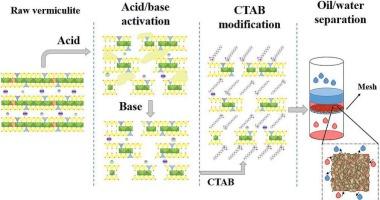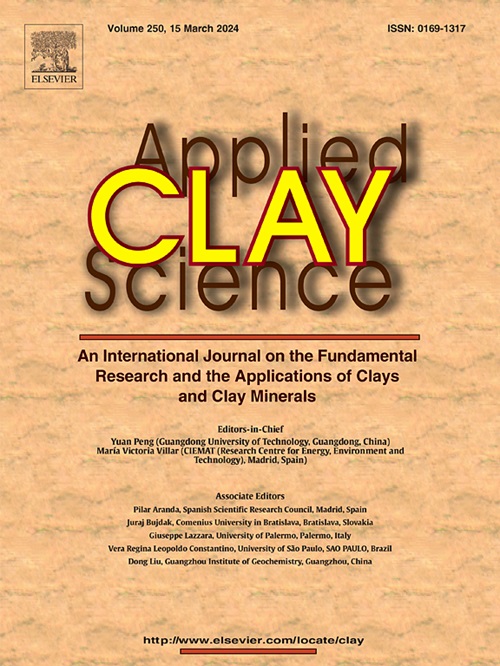Organoclays from acid-base activated vermiculites for oil-water mixture separations
IF 5.3
2区 地球科学
Q2 CHEMISTRY, PHYSICAL
引用次数: 0
Abstract
Oily wastewater discharge causes severe environmental pollution and resource waste, requiring the development of low-cost adsorbents with good hydrophobicity. This study presents the preparation and use of a novel highly hydrophobic adsorbent based on natural vermiculite clay minerals to separate free/emulsified oil-water mixtures. Vermiculite was first activated with sulfuric acid and potassium hydroxide to increase its adsorption capacity and surface area. The sample was then modified with cetyltrimethylammonium bromide (CTAB) to change the wetting properties from hydrophilic to hydrophobic and increase oil adsorption. XRD, XRF, FESEM, BET, FTIR, and zeta potential analyses were carried out to determine changes in texture, morphology, and chemical composition of vermiculite affected by acid, base and acid-base activation. According to the results, the acid-base activation process was selected for vermiculite treatment before CTAB modification, which demonstrated a high oil adsorption selectivity (1910.6 %) compared to raw vermiculite (44.14 %). Effect of CTAB concentration on vermiculite's wetting properties was studied. The results confirmed that the acid-base activated sample modified at 0.9 mmol.L−1 near the critical micelle concentration of CTAB exhibited highly hydrophobic properties (water contact angle of 148° ± 1°). For oil-in-water emulsions, the treated adsorbent demonstrated a high oil removal efficiency of 96 ± 2 %. Additionally, a packed layer of highly hydrophobic vermiculite was applied for free heavy/light oil-water mixture and water-in-oil emulsion separation. The performance test for separation of free oil-water mixture and water-in-oil emulsion showed high separation efficiency (all above 90 %). The reusability of highly hydrophobic vermiculite as well as the effect of oil type, the thickness of the adsorbent layer, and the height of the water phase on separation performance were also investigated.

用于油水混合物分离的酸碱活化蛭石有机粘土
含油废水排放会造成严重的环境污染和资源浪费,因此需要开发具有良好疏水性的低成本吸附剂。本研究介绍了一种基于天然蛭石粘土矿物的新型高疏水性吸附剂的制备和使用方法,用于分离游离/乳化油水混合物。首先用硫酸和氢氧化钾对蛭石进行活化,以增加其吸附能力和表面积。然后用十六烷基三甲基溴化铵(CTAB)对样品进行改性,使其润湿性能从亲水性变为疏水性,从而增加对油的吸附。通过 XRD、XRF、FESEM、BET、FTIR 和 zeta 电位分析,确定了蛭石在酸、碱和酸碱活化作用下的质地、形态和化学成分的变化。结果表明,在 CTAB 改性之前,选择酸碱活化工艺处理蛭石,与未加工的蛭石(44.14%)相比,该工艺具有较高的吸油选择性(1910.6%)。研究了 CTAB 浓度对蛭石润湿性能的影响。结果证实,在 0.9 mmol.L-1 接近 CTAB 临界胶束浓度的条件下改性的酸碱活化样品具有高度疏水特性(水接触角为 148° ± 1°)。对于水包油乳剂,经过处理的吸附剂具有 96 ± 2 % 的高除油效率。此外,高疏水性蛭石填料层还用于分离游离重/轻油水混合物和油包水乳剂。分离游离油水混合物和油包水乳液的性能测试表明,分离效率很高(均高于 90%)。此外,还研究了高疏水性蛭石的重复利用率以及油类、吸附剂层厚度和水相高度对分离性能的影响。
本文章由计算机程序翻译,如有差异,请以英文原文为准。
求助全文
约1分钟内获得全文
求助全文
来源期刊

Applied Clay Science
地学-矿物学
CiteScore
10.30
自引率
10.70%
发文量
289
审稿时长
39 days
期刊介绍:
Applied Clay Science aims to be an international journal attracting high quality scientific papers on clays and clay minerals, including research papers, reviews, and technical notes. The journal covers typical subjects of Fundamental and Applied Clay Science such as:
• Synthesis and purification
• Structural, crystallographic and mineralogical properties of clays and clay minerals
• Thermal properties of clays and clay minerals
• Physico-chemical properties including i) surface and interface properties; ii) thermodynamic properties; iii) mechanical properties
• Interaction with water, with polar and apolar molecules
• Colloidal properties and rheology
• Adsorption, Intercalation, Ionic exchange
• Genesis and deposits of clay minerals
• Geology and geochemistry of clays
• Modification of clays and clay minerals properties by thermal and physical treatments
• Modification by chemical treatments with organic and inorganic molecules(organoclays, pillared clays)
• Modification by biological microorganisms. etc...
 求助内容:
求助内容: 应助结果提醒方式:
应助结果提醒方式:


